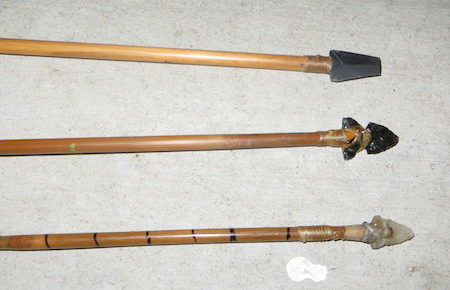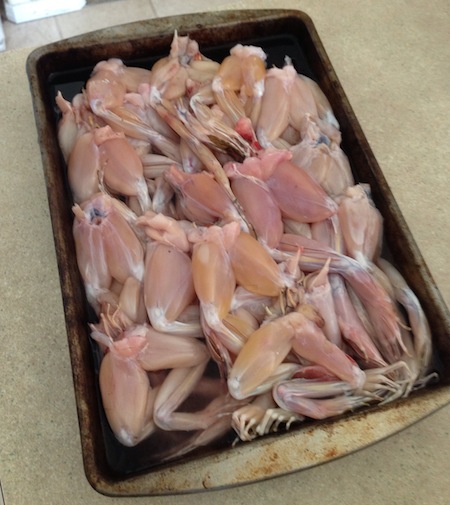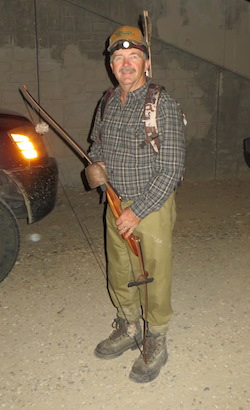Blame it on Duck Dynasty if you want, or maybe on the cacophonous croaking of frogs along the canal near my home, but I have developed a taste for bull frogs. Frogging is considered a summertime pleasure for many of my southern-born friends. It is a rite of passage to muck through the swamp after these amphibians. Bow in hand, I head to the swamp each year…in the high desert of Idaho.

No special equipment is needed to bow hunt frogs. A blunt or a field tip will work fine for stunning them. I have used my bowfishing equipment on several occasions. My father’s preferred method is obsidian-tipped bamboo self arrows. However, his special trick is to use broken points: blunt enough to cause trauma, but sharp enough to penetrate.
Frog hunting is a nighttime affair. A hunter first listens for the telltale croak of a bull frog. The bull frog croak is a low guttural sound, somewhat reminiscent of a mating bull cow, thus the name. When a frog is audibly located, the hunter turns on the flashlight and starts looking for white eyes reflecting light. When the eyes are spotted, the hunter must keep the light on the frog to keep it “mesmerized.” Removing the light from the frog’s eyes would allow it to break the trance and duck away. As long as the light is shining on the frog, it will stay in one place and allow the hunter to approach with his bow. With a well-placed arrow into the frog, the hunter has just bagged part of a nice meal.
After the shot, get over to your arrow as fast as possible. I have watched several of my arrows disappear, never to come out of the muck again. Dad even lost one in the reeds as a big croaker bounded off. It is hard to find a bamboo shaft in cattail reeds.
Often, the frogs are not dead after the arrow hits them. This means a quick knife to the head, or a whack with a club. Something to finish the job is needed, otherwise you will be chasing wounded frogs each time you open your game bag.
Culinary-wise, frogs are often called “swamp chicken” for good reason. They are a soft white meat that is like a combination of chicken and fish: delicate, yet chewy.
To process the frogs, cut them in half at the waist, then pretend you are taking the pants off them with a pair of pliers–no joke! Soak the legs in salt water for a day. This will do two things: make most of the big black veins turn translucent, and thus more palatable to those who do not eat frog; and the salt water will brine the frogs, keeping them moist during the cooking process.
Cooking them is easy. To quote a nice Southern gentleman I met on a plane headed to Louisiana: “Get a Dutch oven and fill it with about two or three inches of fry oil–you know, Crisco or canola, whatever.” said John. “Then you need to pat the frogs off with a paper towel, roll them in seasoned flour, put them in milk and then seasoned flour again. Deep fry them until they are brown. Don’t mess with perfection!”
You will need:
12 “pairs” of frog legs
Seasoned Frog Flour:
- 1 cup flour
- 1 teaspoon “Red Pepper” AKA cayenne pepper
- 1 tablespoon salt
- 1 tablespoon pepper
3 cups Crisco, or enough to fill a Dutch Oven 2-3 inches
1 cup milk
Directions:
 Heat the oil in the Dutch oven on the stove until a wooden spoon floats and gives off small bubbles, or about 350 degrees on a candy thermometer. Keep it at that heat.
Heat the oil in the Dutch oven on the stove until a wooden spoon floats and gives off small bubbles, or about 350 degrees on a candy thermometer. Keep it at that heat.- Mix all the dry ingredients with the flour in a small bowl. Reserve.
- Pour milk in into a small bowl.
- Pat the frogs dry after soaking them.
- Roll them in seasoned flour, then dunk them in milk. This will create a sticky surface for the second dredging of flour. Next roll and slightly press the flour again on the frog legs.
- Fry the legs in sets of three at a time, until golden brown. Fry time is about 4-5 minutes. Transfer them to a paper towel lined plate. Serve hot. Squeeze some lemon on them, if you want, or just grub down on them!
For more recipes and wild game related stories please visit www.chefrandyking.com










Awesome Read! Thanks for sharing this.
How do these frogs legs freeze? I’d like to gather a bunch in summer, cook them up, freeze them and take them to the deer camp. (I’ll have to check possession limits. Apparently there is a season on them here in Ontario.)
Hi Dennis. Randy King replied with the following:
Frog legs freeze just fine. We usually have enough for a batch in the summer right after the hunt and a batch fried up in the winter. Almost all commercially available frog legs some frozen too. Chill them first then freeze them vacuum sealed under the fan in the freezer.